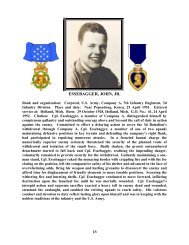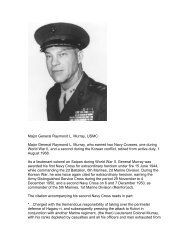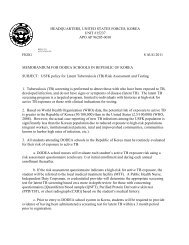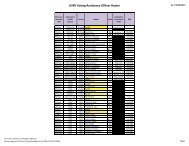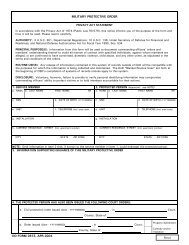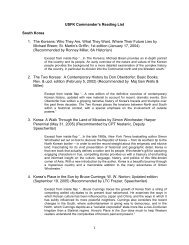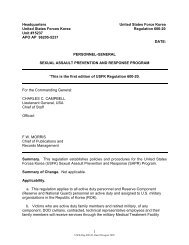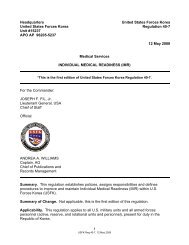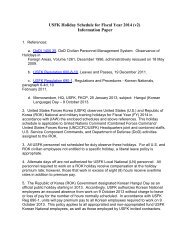Curtis Utz, Assault from the Sea, The Amphibious Landing, Naval ...
Curtis Utz, Assault from the Sea, The Amphibious Landing, Naval ...
Curtis Utz, Assault from the Sea, The Amphibious Landing, Naval ...
You also want an ePaper? Increase the reach of your titles
YUMPU automatically turns print PDFs into web optimized ePapers that Google loves.
Conclusion<br />
he amphibious assault<br />
at Inchon showed how<br />
<strong>the</strong> skillful use of naval<br />
force enables <strong>the</strong>ater commanders<br />
to bring decisive<br />
power to bear on enemy nations<br />
touched by <strong>the</strong> sea. <strong>The</strong> cruisers,<br />
destroyers, frigates and<br />
carriers, along with UN air<br />
forces, first secured control<br />
of <strong>the</strong> Yellow <strong>Sea</strong>, <strong>the</strong> <strong>Sea</strong> of<br />
Japan and <strong>the</strong> air spaces<br />
over <strong>the</strong>se waters. This unexpected<br />
display of strength<br />
led North Korea’s international<br />
Communist supporters<br />
to reconsider <strong>the</strong>ir policies<br />
regarding <strong>the</strong> Korean peninsula.<br />
After eliminating <strong>the</strong> North<br />
Korean air force, UN ship- and<br />
land-based air power battered<br />
military facilities in North<br />
Korea and logistical lines to<br />
<strong>the</strong> Communist troops in<br />
South Korea. At <strong>the</strong> same<br />
time, U.S. and Royal Navy<br />
warships bombarded NKPA<br />
front-line troops and supply<br />
routes near <strong>the</strong> coasts, providing<br />
vital support to <strong>the</strong><br />
U.S. and ROK ground units.<br />
Because of post-World War<br />
II defense cutbacks, however,<br />
<strong>the</strong> lack of ships, aircraft<br />
and material ready for combat<br />
almost doomed <strong>the</strong> UN<br />
cause in Korea in July and<br />
August 1950.<br />
Control of <strong>the</strong> sea and <strong>the</strong><br />
ability to assemble and organize<br />
enough merchantmen,<br />
transports and cargo ships<br />
allowed <strong>the</strong> UN command to<br />
move reinforcements to <strong>the</strong><br />
Far East <strong>from</strong> all parts of<br />
<strong>the</strong> world. General MacArthur,<br />
<strong>the</strong> <strong>the</strong>ater commander and<br />
Rear Admiral James H. Doyle, who one Marine general regarded as “<strong>the</strong> best amphibious<br />
naval officer I have ever met,” awards Silver Star medals for bravery to<br />
landing craft sailors (left to right) <strong>Sea</strong>man Chantey H. Vogt, <strong>Sea</strong>man William H.<br />
Tagan, Engineman Fireman Richard P. Vinson and <strong>Sea</strong>man Apprentice Paul J. Gregory.<br />
an experienced practitioner<br />
of amphibious warfare,<br />
knew that he now possessed<br />
a clear advantage over his<br />
enemy. He was able to choose<br />
<strong>the</strong> best time and place to<br />
strike <strong>the</strong> rear of <strong>the</strong> North<br />
Korean army. If success<br />
crowned his efforts, he<br />
would liberate South Korea.<br />
<strong>The</strong> naval forces in <strong>the</strong> Far<br />
East, under <strong>the</strong> command of<br />
Admirals Joy, Struble and<br />
Doyle, <strong>the</strong>n worked to execute<br />
MacArthur’s concept. Despite<br />
<strong>the</strong> difficulties in ga<strong>the</strong>ring<br />
relevant intelligence and assembling<br />
<strong>the</strong> variety of units<br />
needed, <strong>the</strong>se veteran commanders<br />
and <strong>the</strong>ir expert<br />
staffs quickly planned <strong>the</strong><br />
assault of a site that presented<br />
many physical<br />
problems. <strong>The</strong>y <strong>the</strong>n coordinated<br />
<strong>the</strong> necessary naval,<br />
air and ground force for <strong>the</strong><br />
complex operation.<br />
Almost every type of naval<br />
unit contributed to <strong>the</strong><br />
victory at Inchon. Carrierbased<br />
Navy and Marine<br />
planes and surface combatants<br />
prepared <strong>the</strong> battlefield<br />
and, in conjunction with <strong>the</strong><br />
Air Force, helped to deceive<br />
<strong>the</strong> enemy about <strong>the</strong> actual<br />
invasion area. Continued<br />
attacks by naval air and surface<br />
forces throughout <strong>the</strong><br />
landing, consolidation and<br />
breakout phases of Chromite<br />
added considerably to <strong>the</strong><br />
woes of <strong>the</strong> North Korean<br />
defenders. O<strong>the</strong>r naval units<br />
cleared Inchon’s approach<br />
waters of mines. Most importantly,<br />
<strong>the</strong> sailors manning<br />
<strong>the</strong> assault ships and craft<br />
and <strong>the</strong> Marines storming<br />
<strong>the</strong> enemy’s positions exhib-<br />
48



